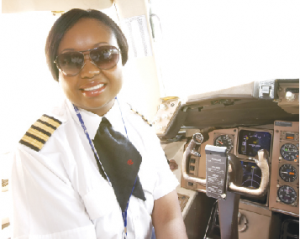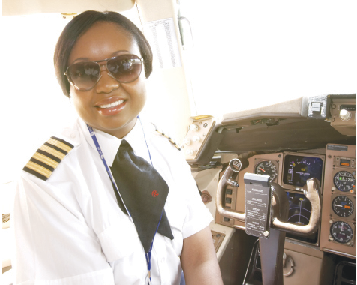Pilots and airline technicians are among the global most rising and competitive jobs, as their demand will continue to rise for years to come.
Boeing’s 2015 Pilot and Technician Outlook report says airlines need almost 1.2 million pilots and technicians to meet aviation job explosion by 2034.
The report forecasts showing continued strong demand for commercial airline pilots and maintenance technicians as the world’s airlines add 38,000 airplanes to the global fleet over the next 20 years.
Captain Irene Koki Mutungi, Kenya Airways.

Between 2015 and 2034, the world will require 558,000 new commercial airline pilots and 609,000 new commercial airline maintenance technicians, according to the report.
“To help address this need, Boeing trained last year a record number of pilots and technicians at 17 training campuses around the globe and has invested in a comprehensive Pilot Development Programme to train early stage pilots to become qualified commercial airline pilots,” said Sherry Carbary, Boeing Flight Services Vice President.
Carbary
“We will continue to increase the amount of training we provide, enabling our customers to satisfy the world’s growing appetite for air travel.”
That is more than what was previously expected, with Boeing forecasting a 4 per cent greater need for pilots than it estimated in 2014, and a roughly 5 per cent uptick in demand for technicians versus last year’s forecast.
As economies around the globe are growing, it enables more people to travel, which in turn leads to carriers having to add 38,000 airplanes to the global airline fleet between now and 2034.
This in turn fuels the need to hire hundreds of thousands of professionals to fly them and keep them in top shape.
“We will continue to increase the amount of training we provide, enabling our customers to satisfy the world’s growing appetite for air travel,” Carbary said.
“The challenge of meeting the global demand for airline professionals will not be solved by one company alone.
“Aircraft manufacturers, airlines, training equipment manufacturers, training delivery organisations, regulatory agencies and educational institutions are all stepping up to meet the increasing need to train and certify pilots and technicians.”
Boeing’s 2015 Outlook projects continued increases in pilot demand, up more than 4 per cent compared to the 2014 Outlook. For maintenance technicians, demand increased approximately 5 per cent.
Overall global demand for these skilled resources will be driven by continued economic expansion, resulting in an average requirement for about 28,000 new pilots and more than 30,000 new technicians every year.
The 20-year projected demand for new pilots and technicians by region is:
• Asia Pacific – 226,000 pilots; 238,000 technicians
• Europe – 95,000 pilots; 101,000 technicians
• North America – 95,000 pilots; 113,000 technicians
• Latin America – 47,000 pilots; 47,000 technicians
• Middle East – 60,000 pilots; 66,000 technicians
• Africa – 18,000 pilots; 22,000 technicians
• Russia / CIS – 17,000 pilots; 22,000 technicians
The Pilot and Technician Outlook is Boeing’s long-term forecast of the demand for pilots and technicians and its estimate of personnel needed to fly and maintain the tens of thousands of new commercial jetliners expected to be produced over the next 20 years.
The forecast is published annually to factor in changing market forces affecting the industry. Boeing shares the outlook with the public to inform airlines, suppliers, and the financial community of trends in the industry.











